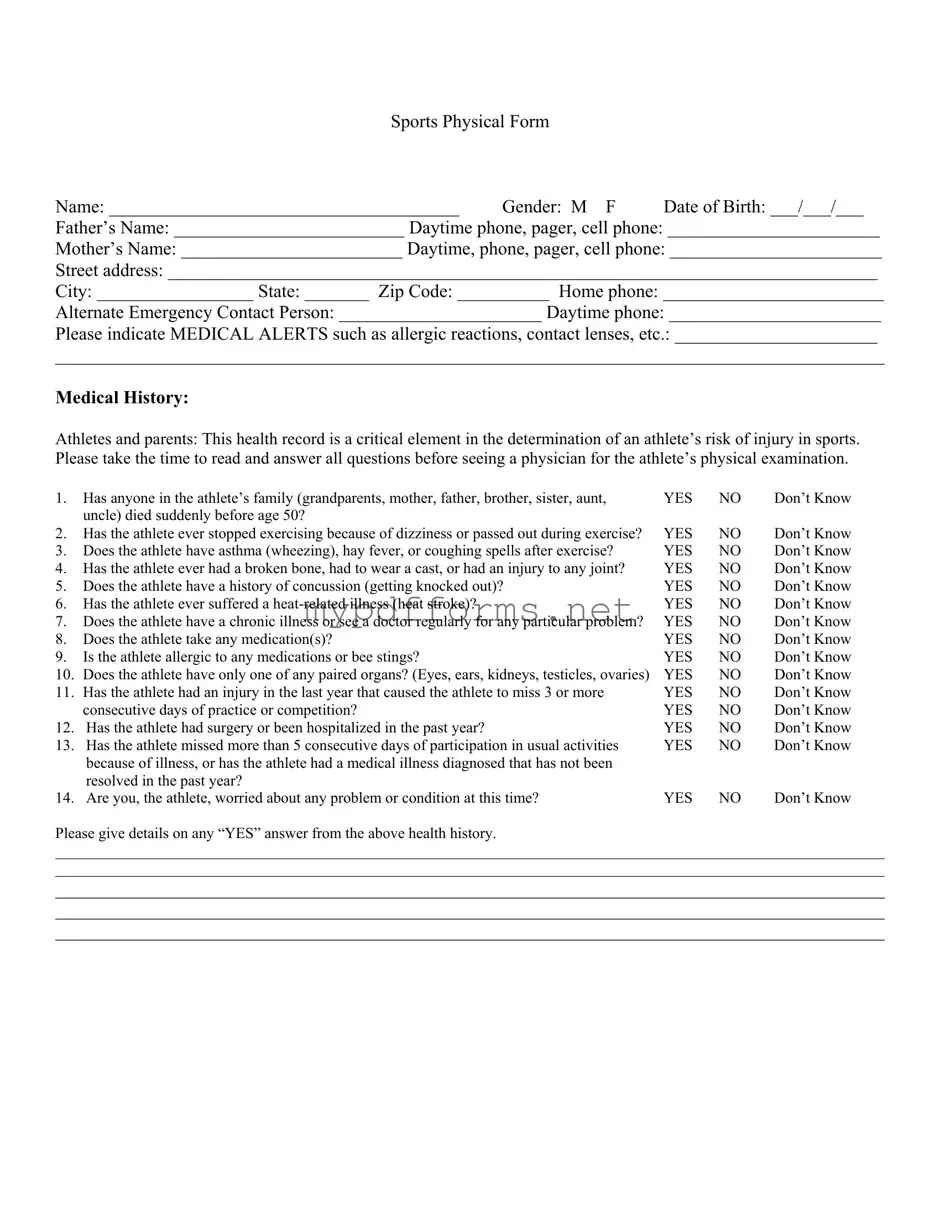The Sports Physical form shares similarities with the School Health Form, which is commonly used to assess a child's overall health before they enter school. Both documents require detailed medical history and personal information, ensuring that any existing health issues are documented. The School Health Form also includes sections for parental contact information and emergency contacts, much like the Sports Physical form. This helps schools maintain a comprehensive understanding of a child's health status and any potential risks that could affect their participation in school activities.
Another document akin to the Sports Physical form is the Camp Health Form. Similar to the Sports Physical, the Camp Health Form collects vital health information about campers, including medical history, allergies, and current medications. Both forms emphasize the importance of understanding a participant's health risks, particularly in a group setting. The Camp Health Form also seeks parental consent for medical treatment, mirroring the need for informed consent present in the Sports Physical form.
The College Health History Form is yet another document that bears resemblance to the Sports Physical form. This form gathers comprehensive health information from incoming college students, including immunization records and medical history. Both forms aim to ensure that participants are fit for physical activity and to identify any health issues that may require attention. Additionally, the College Health History Form often includes a section for a physical examination, just like the Sports Physical, reinforcing the need for a thorough health assessment.
The Medical Release Form is closely related to the Sports Physical form in that it grants permission for medical treatment in case of an emergency. Both documents require parental signatures and emphasize the importance of having accurate medical information readily available. While the Sports Physical focuses on fitness for sports, the Medical Release Form is more about ensuring that emergency responders have the necessary information to provide appropriate care when needed.
The Pre-Participation Physical Evaluation (PPE) form is another document that aligns with the Sports Physical form. The PPE is specifically designed for athletes and includes questions about medical history and current health status. Like the Sports Physical, it assesses the athlete's readiness to participate in sports and identifies any potential health concerns. Both forms require a physician's examination and signature, ensuring that athletes are cleared for participation.
The Patient Intake Form is similar in that it collects essential health information before a medical appointment. This form gathers personal and family medical history, current medications, and allergies. Both the Patient Intake Form and the Sports Physical form aim to provide healthcare professionals with a comprehensive view of a patient’s health, helping them make informed decisions about care and treatment.
The Immunization Record is another document that shares a common purpose with the Sports Physical form. Both documents require detailed health information and are often needed for participation in various activities, including sports and school. The Immunization Record specifically tracks vaccinations, which is crucial for preventing illness in group settings, while the Sports Physical focuses on overall health and fitness for athletic participation.
To understand the importance of preemptive planning, consider the advantages of having a comprehensive Durable Power of Attorney document. This form enables you to appoint someone to make crucial decisions on your behalf, safeguarding your interests in scenarios where you may be unable to communicate them yourself.
The Health Insurance Portability and Accountability Act (HIPAA) Release Form is relevant as it allows healthcare providers to share medical information. While it serves a different purpose, both the HIPAA Release Form and the Sports Physical form prioritize the confidentiality and management of health information. They ensure that necessary medical details are accessible to those who need them, particularly in emergency situations.
Lastly, the Return-to-Play Form is similar to the Sports Physical form in that it assesses an athlete's readiness to return to sports after an injury or illness. This document typically requires a physician's approval, just like the Sports Physical. Both forms are crucial for ensuring the safety and health of the athlete, emphasizing the need for a thorough evaluation before resuming physical activity.
